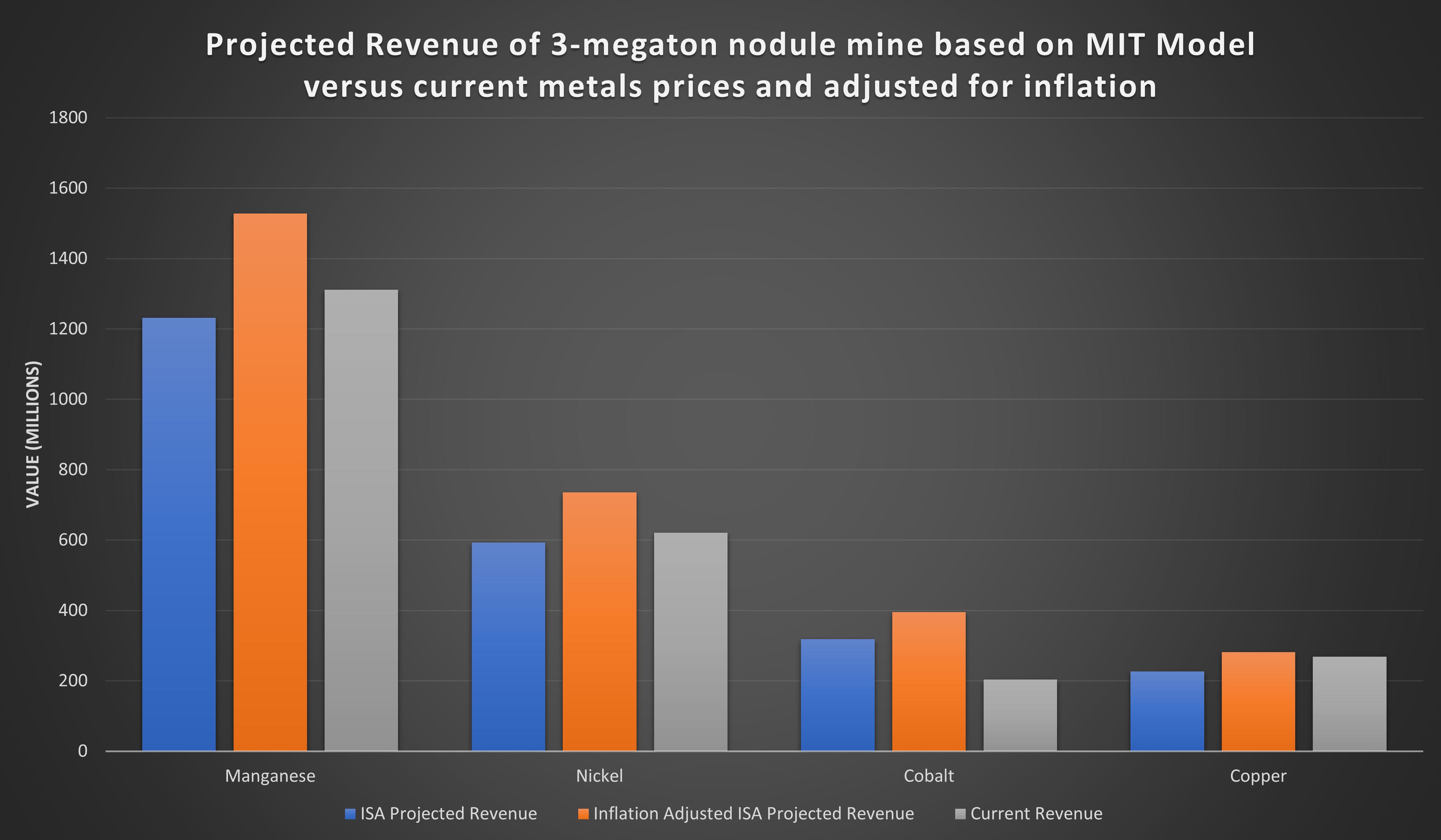On April 28, 2022, I was invited to give a short talk to a gathering of Environmental NGO representatives to provide an overview and my perspective on the current state of development for deep-sea mining. Below is the transcript of that talk.

Good afternoon and thank you for inviting me. Today I’m going to give you a very brief whirlwind tour of the current state of deep-sea mining and the policy regime around this developing industry.

The first thing I need to highlight is that we often talk about deep-sea mining as one cohesive thing, but it’s really four separate and distinct industries, all developing in tandem, with significant differences in the types of metals targeted, the technology necessary to exploit those metals, and the motivations for doing so.
The approach that gets the most headlines and raises the most protest is hydrothermal vent mining, what the industry calls seafloor massive sulphides. Hydrothermal vents are rich in gold, silver, and copper, but they also host these massive, iconic ecosystems that can be found nowhere else on the planet. If the average person knows anything about the deep-sea, they generally know about hydrothermal vents. And mining them requires the comprehensive destruction of the entire vent system. The chemical energy that drives these ecosystems is the same chemical energy that creates metal deposits. The vent is the ore. In fact, many terrestrial gold mines are the stockworks of ancient hydrothermal vents.
Vent mining had a moment in the 2000s and 2010s, primarily because of one deposit off the coast of Papua New Guinea that was close to shore, incredibly valuable, and politically relatively uncomplicated because it only involved one country. But relatively uncomplicated turned out to still be massively complex, and that endeavor failed fairly spectacularly. This is actually a photo from that prospect, called Solwara I, which is where I did most of my PhD work.
The approach that rarely gets discussed is mining cobalt-rich or ferromanganese crusts. These crusts form as deposits on the surface of seamounts, and they can be rich in cobalt, obviously, but also more exotic metals like scandium, which is used in the aerospace industry, and tellurium which is used in high-efficiency solar panels. But they’re also seamounts, so not only do they support large, diverse deep-sea habitats, but they also may act as nursery grounds for commercially important fish species. Cobalt-rich crusts are interesting because they represent the one deep-sea mining case where there’s a clear industry-to-industry conflict.
But for both hydrothermal vents and cobalt-rich crusts, the actual process of mining is comprehensively destructive, the vent or the crust supports relatively rare ecosystems in the deep-sea and there’s no practical way to exploit them without destroying the overlying biota. And for that reason, both methods have fallen generally out of favor within the larger deep-sea mining industry. There are still contractors proposing to mine vents and crusts, but the actual development of mining capacity is in its infancy and the funding is relatively light.
Where we’re actually seeing rapid development of deep-sea mining capacity is with polymetallic nodules. With the exception of that moment in the 2010s, polymetallic nodules have been the main focus of deep-sea mining since the 1960s, so most of the rest of this discussion is going to center around nodule mining.
But I do want to briefly mention the fourth “industry” within deep-sea mining, and that is what I call geopolitical deep-sea mining. For many nations, there are strategic reasons to participate in the development of the mining industry that have little to do with actually recovering ore from the seafloor at commercial scales. Russia, famously, has been campaigning for decades to establish their sovereignty over a significant portion of the high arctic and views their work with the International Seabed Authority as a component of that effort. China controls about 90% of the terrestrial metal supply for many of the proposed targets for deep-sea mining, either directly or indirectly through their Belt and Road policy, and has a vested interest in ensuring that deep-sea mining doesn’t develop in a way that compromises their supply dominance. So it’s important to remember that many of the most influential state players in the development of deep-sea mining may not necessarily be all that interested in the actual mining part.

Polymetallic nodules are weird. They’re rocks, but they grow. They form as minerals in seawater accrete around some kind of hard nucleating agent. Sometimes if you cut them open, you’ll find a shark’s tooth, but more often a diatom test. And they just sit on the seafloor. They aren’t attached to anything. And they don’t really bury themselves, either. Their always at the surface, rarely in the sediment. And we’re really not sure why. But they’re rich in cobalt, nickel, and manganese, all elements that are currently essential to battery production for electric vehicles. And that’s the value proposition from the industry: we need a lot more metals in order to transition away from fossil fuels, and deep-sea mining is a more sustainable way to access those metals. But ecosystems do form around them and on top of them. They support endemic species of worms and sponges and other infauna and, while biomass around these nodule deposits may appear low, the biodiversity is astounding. But, unlike vents and crusts, nodule deposits are huge. They’re found over something like 60% of the abyssal plain. Hydrothermal vents are so rare that the total surface area of all known and hypothesized vents is smaller than Manhattan. Nodules fields may comprise the largest ecosystem on the planet.
So you can see why there are folks, even within the environmental community, who think that deep-sea mining of polymetallic nodules might be our last best chance to free us from our fossil fuel addiction.

But there are, of course, environmental consequences to deep-sea mining, and most of those consequences are still unknown. Collecting nodules may have a lighter touch than stump-grinding a hydrothermal vent, but it still disrupts an ecosystem that took millions of years to form. Hard surfaces are valuable to deep-sea animals, and so many creatures live on the nodules. And the process of nodule harvesting, which involves using a deep-sea robot that crawls across the seafloor, scoops up nodules, and then pumps them to the surface through a riser and lift system for downstream processing, can have other impacts. The system produces sediment plumes, both at the seafloor and at the surface and midwater, which could smother surrounding ecosystems. It produces significant marine noise. Having an aircraft carrier-sized ship on station for months produces all the impacts that large vessels produce, and the ore still needs to be refined and processed, somewhere, with all the related impacts that come with refining and processing.
So, here’s where I admit that I remain undecided. I do believe that there is a version of polymetallic nodule mining that has the potential to produce the metals we need for the electrification of the world’s automotive fleet in a way that represents a responsible compromise between the direct impacts of nodule extraction and the existential threat of failing to get emissions under control before the worst predictions of the International Panel on Climate Change become inevitable. I think it’s very hard to argue that polymetallic nodule mining is worse for the world than strip mining Indonesia’s remaining rainforests for nickel or having the children of Congo dig for cobalt.
But boy oh boy there are some caveats. And the biggest one is that deep-sea mining is an additive impact. It won’t replace any of those other forms of mining, and, in fact, within the international policy regime, it shouldn’t adversely impact the terrestrial industries of ISA member states. The other big caveat is that the timeline of deep-sea mining just does not match the urgency of climate change. There’s no deep-sea mining proposal that reaches significant commercial production by 2030. Deep-sea mining isn’t a player in the most important decade for avoiding the worst impacts of climate change. It won’t get us to 2030, but if done right, it might get us to 2050.
This presents a really interesting opportunity. Because deep-sea mining is not urgent, that means we have time to get it right, to understand the environmental impacts and tradeoffs, to put in place good policy and good governance, before an ounce of commercial ore is removed from the seafloor.

Unfortunately, that’s where the International Seabed Authority comes in. And if any of you read Todd Woody’s recent article in the LA Times, you know that the best way to describe the current structure of the ISA, and particularly the administrative arm of the ISA, the Secretariat, is “dysfunctional”. The ISA is the international body tasked with establishing the mining code that will allow companies to mine seafloor resources in areas beyond national jurisdiction. It’s a creation of The UN Convention on the Law of the Sea, and its mandate is to both promote the development of deep-sea mining and protect the marine environment, for the good of humankind, which many note is an inherent conflict of interest.
I’m not going to go deep into the weeds on the structure of the ISA, but I will highlight three emerging issues that will likely be the overwhelming driver of the next few years of mining negotiations.
The first is the Trigger. Last summer, a sponsoring state – all mining companies must be sponsored by an ISA member state – invoked an obscure article of the Convention which forces the ISA to finish the mining code within a two-year window. This mechanism exists to prevent someone from stonewalling progress if a company is ready to mine and nothing but the lack of a mining code is preventing them from doing so, but at the moment, no one is actually ready to mine. So there’s now a rush to develop a Mining Code and all the associated standards and guidelines for deep-sea mining before June 2023.
On top of that, there’s currently a major fight over the composition of the Legal and Technical Commission. The LTC is a collection of experts who review all of the technical documents and advise the ISA on whether or not to approve them. The ISA has never voted against the recommendation of the LTC so this commission is the de facto entity that gets to decide how and when deep-sea mining gets to move forward. And, to no one’s surprise, the geographic representation of the LTC is biased heavily in favor of pro-mining states and underrepresents Africa, South America, and Oceania. (Note: since this talk was presented, the ISA has made some steps to address these issues)
And finally, there’s the financial regime, which determines how member states get paid when resources of the deep sea get mined. Because, remember, the ISA considers these minerals to be property of the Common Heritage of Mankind. Which mean they’re mine, and they’re yours, and they belong to Columbia and Sri Lanka and Ukraine and they also belong to future generations. UNCLOS is occasionally a breathlessly progressive document. So if someone mines, they have to pay. And after 27 years of negotiations, no one has yet figured out how that compensation should work.
There’s a lot of other issues in play and the last ISA meeting that just wrapped up was fairly dramatic, but I’m going to leave it at those three for now.
And it’s worth mentioning that the Mining Code will apply to all kinds of deep-sea mining, but is being developed with a specific focus on nodule mining.

So we should probably end with who is actually driving these developments. There are three major private companies and a handful of member states who are most deeply involved in moving deep-sea mining forward. There’s the Metals Company out of Canada, who are sponsored by Nauru and have nodule claims predominantly in the middle of the Pacific. GSR is EU-based, and it’s supported by its parent company, DEME, which is the world’s largest dredging company. UKSR is a subsidiary of Lockheed and has lots of smaller plays, but stays relatively quiet. And there’s a newcomer, Impossible Mining, which wants to used neutrally buoyant AI-powered autonomous robots to gently pluck nodules from the seafloor without producing a plume, but they are in very early development and as far as I know, don’t have any mining leases, yet.
On the nation side, China, South Korea, India, Japan, and Brazil all have their own state-owned mining companies in various stages of development. India has made a massive investment in deep-sea capacity, including build a 6000-meter capable submarine to match China and Japan’s. China is the only mining contractor that has leases for vents, crusts, and nodules. And Brazil is very interested in cobalt-rich crusts in the mid-Atlantic, which is an entire fascinating story in its own right.
These aren’t the only countries, just the ones who have made significant capacity investments towards commercial mining

There are a lot of things that have to happen, and they are happening fast. The mining code must be approved by 2023, which is a deadline that the ISA will likely miss, placing the burden of approving a plan of work on the LTC. There are at least 2 years of technology trials that need to happen before any of these systems are even ready to begin pilot mining projects. There’s a growing push for a moratorium on deep-sea mining by several environmental NGOs and nations.
And there’s the x-factor. Battery technology is evolving rapidly and many manufacturers, including Tesla, Samsung, Nissan, and others are pushing for next-generation batteries that don’t rely on cobalt or nickel in their chemistries. Much like the demand for manganese crashed at the beginning of the 1980’s, a change in battery chemistry could significantly impact the potential profitability of deep-sea mining.
And if you’ve found it hard to keep up with the ongoing negotiations and the ever fluctuating political winds of the deep-sea mining world, just remember, no one has started mining yet, and, as was often repeated at the last ISA meeting, “nothing is agreed until everything is agreed”.
Thank you.
Southern Fried Science and the OpenCTD project are supported by funding from our Patreon Subscribers. If you value these resources, please consider contributing a few dollars to help keep the servers running and the coffee flowing.


